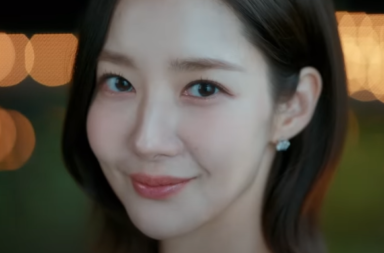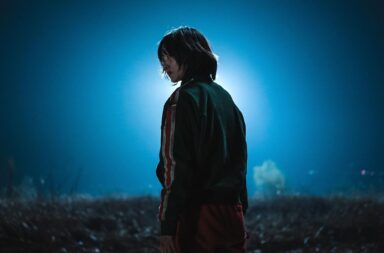
Flower of Evil got off to a strong start. In the first eight episodes, its melodramatic tendencies were tempered by smart writing and complex characterizations. The result was a pulpy thrill-ride with unexpected depth.
All such thoughtfulness is gone in the show’s final run. Just past its halfway mark, Flower of Evil careens into complete soap-opera territory. It wastes the careful character-building of its early chapters by rushing relationship arcs, and prioritizing flashy moments over character continuity. Logic also goes out the window. Drama tropes swoop in to take its place. Insanely coincidental childhood connections? Check. Rain as the ultimate symbol of romance? Check. Last-minute amnesia? A big, clunky check.
And yet, Flower of Evil is compulsively watchable to the very end. While some scenes are laughably absurd, others thrum with energy. The acting is solid across the board. Most importantly, Flower of Evil maintains its momentum. Despite an unplanned break, there are no filler episodes, something that can’t be said of most dramas. It’s hard to deny that Flower of Evil fails to live up to its potential. Even so, it can’t quite be classified as a waste of time. There’s no shame in spending an hour or sixteen with a show this entertaining.
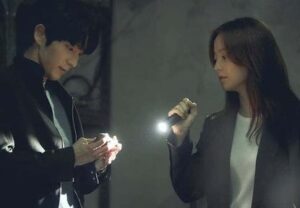
In its opening episodes, Flower of Evil’s four lead characters and their relationships were the main draw. The complex web of connections between Do Hyun-soo (Lee Joon-gi), Cha Ji-won (Moon Chae-won), Kim Moo-jin (Seo Hyun-woo), and Do Hae-soo (Jang Hee-jin) simmered with intensity and intrigue. Unfortunately, they bear the brunt of the drama’s dip in quality.
As Flower of Evil increasingly values expediency over depth, and showy sequences over meaningful ones, the quartet loses more and more of their richness. Simplification reigns supreme. Character becomes caricature.
Hyun-soo suffers the most. Originally, he was a mesmerizing antihero. The drama’s portrayal of his antisocial personality disorder felt refreshingly nuanced, and brought up a lot of tantalizing questions about love: how does it manifest, who is capable of it, and who is deserving of it? In its second half, Flower of Evil runs away from this promising set-up. Hyun-soo’s mental illness is shoved to the background, plucked forth occasionally when narratively convenient, but never properly grappled with. Instead, the show makes a case that the real issue is that Hyun-soo is just misunderstood. All he needs is affection and acceptance and he’ll be okay.
It should go without saying that this is not how mental disorders work. From a viewing perspective, Hyun-soo’s ultimate arc is offensive in its misrepresentation of the realities of mental illness. From a storytelling perspective, it is problematic in an entirely different way.
A sequence from episode 11 shows how. In a heated confrontation with Ji-won, Hyun-soo tearfully begs forgiveness. Rather than being emotionally resonant, the scene is baffling. Flower of Evil has spent its entire first half reiterating that Hyun-soo is not someone who is capable of empathy or guilt. And now he’s having a sudden emotional outburst over how sorry he is? This contradiction robs Hyun-soo of his continuity as a character, making him feel fake as well as fictional. From then on, it is hard to be invested in his story.
Similar inconsistencies weigh down the other protagonists’ narratives, as well as their relationship dynamics. The characters who fare better in Flower of Evil’s final run are the supporting players. Choi Dae-hoon, Kim Soo-oh, and Choi Young-joon are lovable dorks and moral cornerstones as Ji-won’s police colleagues. Han Soo-yeon also deserves recognition for her brief yet memorable appearance as a shell-shocked kidnapping victim. However, the true standout is Kim Ji-hoon, giving a deliciously unhinged performance as Flower of Evil’s ultimate villain, Baek Hee-sung.
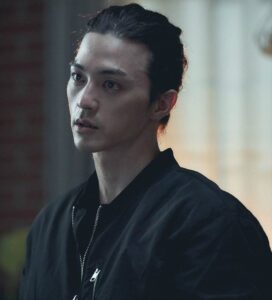
Hee-sung as a character is almost the personification of Flower of Evil’s final episodes. His entire arc is based around absurd leaps in logic. Does it make sense that the protégé of a serial killer would accidentally hit the killer’s son with his car, then get stabbed by his mother and end up in a coma for fifteen years, during which time the killer’s son would assume his identity, failing to realize that he was adopting the name of his father’s accomplice? No, it most certainly does not.
On the other hand, Hee-sung is riveting and his plot is never dull. He’s always up to something fascinatingly menacing, whether whispering psychotic catchphrases, or tying his hair into the world’s most terrifying man bun before a kill. His backstory also contains hints of social commentary. The son of doting and wealthy parents, Hee-sung has somehow turned out to be a total monster. It could be a case of nature over nurture. Or perhaps his privilege actually helped shape him into a vicious killer. Flower of Evil doesn’t fully delve into this line of thought, but it is still a nice touch.
Hee-sung’s villainous antics create many of the drama’s best second-half sequences. His unpredictability makes him feel like a genuine threat, lending the show an air of real suspense. This is especially evident in Flower of Evil’s best late-run entry, episode 15.
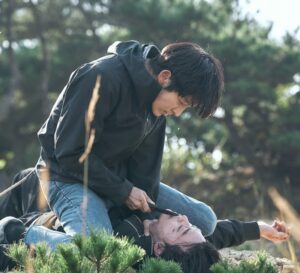
For 75 minutes, Flower of Evil is pretty perfect. Because the action of episode 15 is so propulsive, the character inconsistencies and plot holes simply slide out of your mind. Each performer gives their all as narrative arcs reach climactic peaks. Everything culminates in a picturesque showdown on a cliff, a scene that expertly combines physical combat with gripping moral conundrums. It’s a really solid episode of television, and a blast to watch.
Unfortunately, the drama can’t maintain these heights through its finale. Flower of Evil slips right back into bad habits, relying on tropes and platitudes to carry it through to the ending credits. Nonetheless, the pleasant aftertaste of episode 15 lingers.
Flower of Evil is full of lazy writing and lost opportunities. Somehow though, its moments of brilliance are what stick most in your memory. This isn’t one of those dramas that is finished with a bitter sigh. Instead, a wry yet light-hearted shrug seems appropriate. It could have been better, that’s for sure. But it was still an entertaining ride.
(Mayo Clinic, Naver, YouTube. Images via CJ E&M, tvN, Viki)

